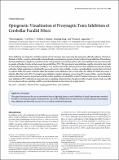Optogenetic Visualization of Presynaptic Tonic Inhibition of Cerebellar Parallel Fibers
Author(s)
Berglund, K.; Wen, L.; Dunbar, R. L.; Feng, G.; Augustine, G. J.
Download5709.full.pdf (3.216Mb)
PUBLISHER_CC
Publisher with Creative Commons License
Creative Commons Attribution
Terms of use
Metadata
Show full item recordAbstract
Tonic inhibition was imaged in cerebellar granule cells of transgenic mice expressing the optogenetic chloride indicator, Clomeleon. Blockade of GABA A receptors substantially reduced chloride concentration in granule cells due to block of tonic inhibition. This indicates that tonic inhibition is a significant contributor to the resting chloride concentration of these cells. Tonic inhibition was observed not only in granule cell bodies, but also in their axons, the parallel fibers (PFs). This presynaptic tonic inhibition could be observed in slices both at room and physiological temperatures, as well as in vivo, and has many of the same properties as tonic inhibition measured in granule cell bodies. GABA application revealed that PFs possess at least two types of GABA A receptor: one high-affinity receptor that is activated by ambient GABA and causes a chloride influx that mediates tonic inhibition, and a second with a low affinity for GABA that causes a chloride efflux that excites PFs. Presynaptic tonic inhibition regulates glutamate release from PFs because GABA A receptor blockade enhanced both the frequency of spontaneous EPSCs and the amplitude of evoked EPSCs at the PF-Purkinje cell synapse. We conclude that tonic inhibition of PFs could play an important role in regulating information flow though cerebellar synaptic circuits. Such cross talk between phasic and tonic signaling could be a general mechanism for fine tuning of synaptic circuits.
Date issued
2016-03Department
Woods Hole Oceanographic InstitutionJournal
Journal of Neuroscience
Publisher
Society for Neuroscience
Citation
Berglund, K. et al. “Optogenetic Visualization of Presynaptic Tonic Inhibition of Cerebellar Parallel Fibers.” Journal of Neuroscience 36, 21 (May 2016): 5709–5723 © 2016 The Author(s)
Version: Final published version
ISSN
0270-6474
1529-2401